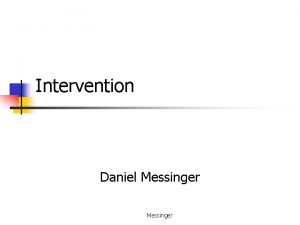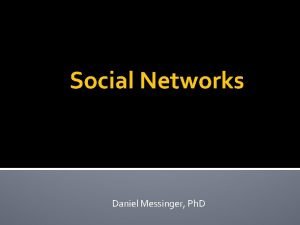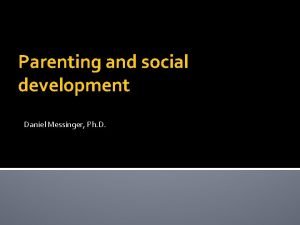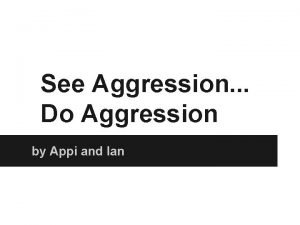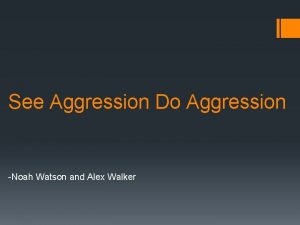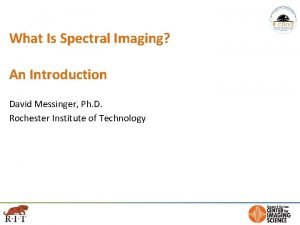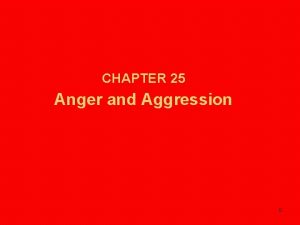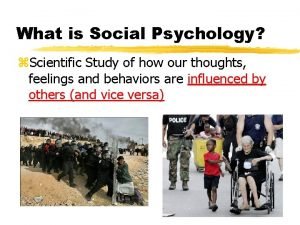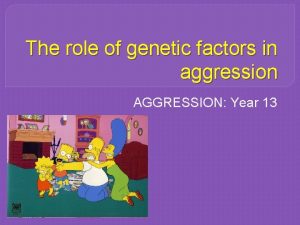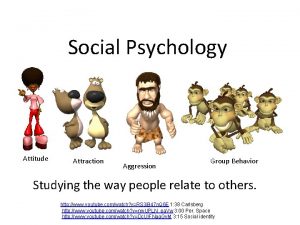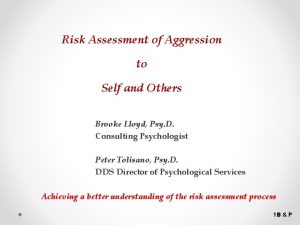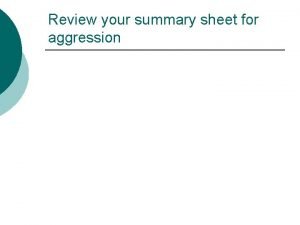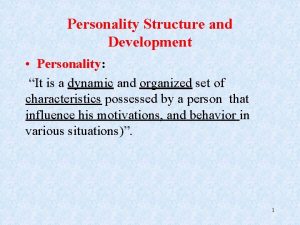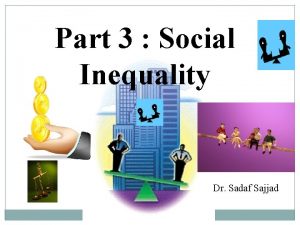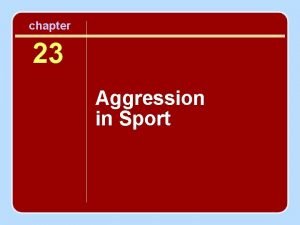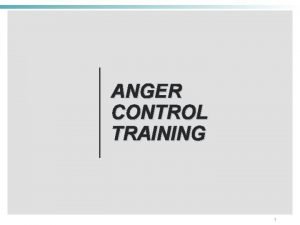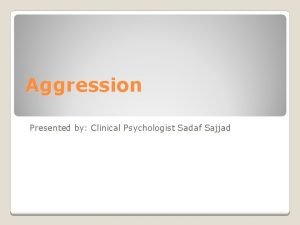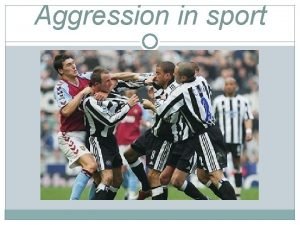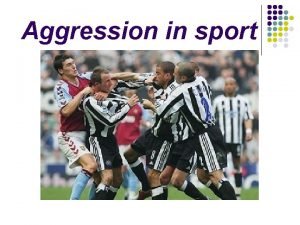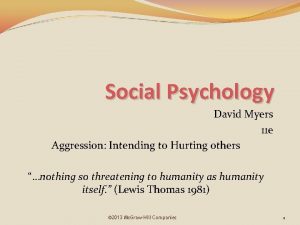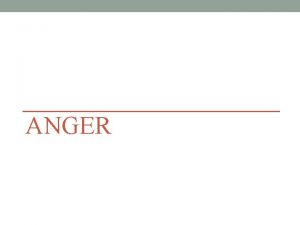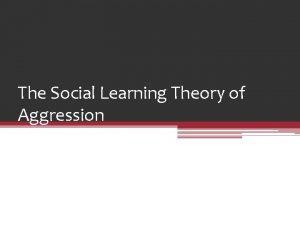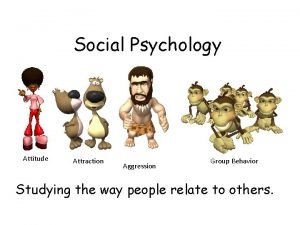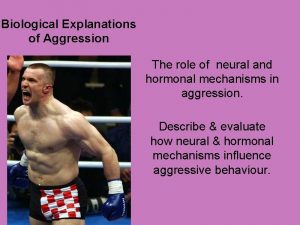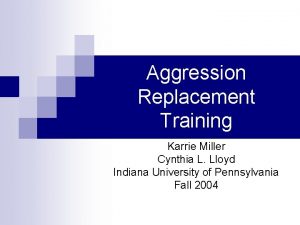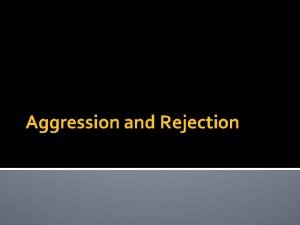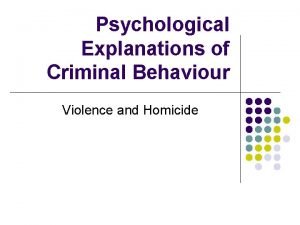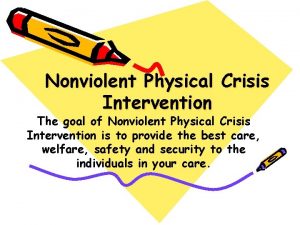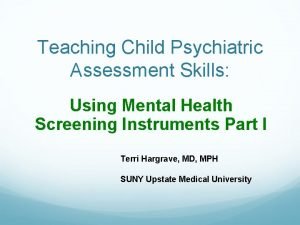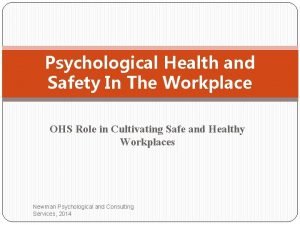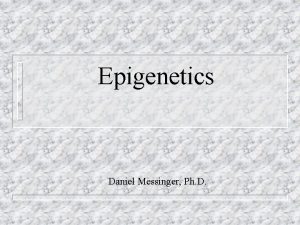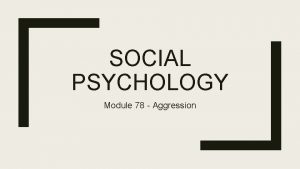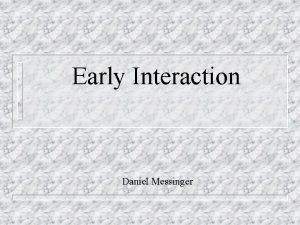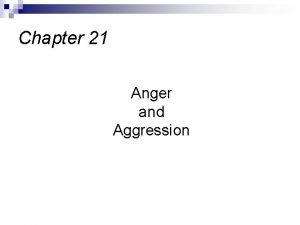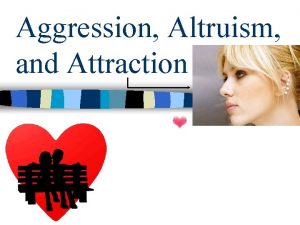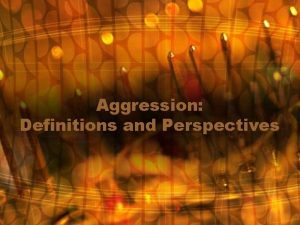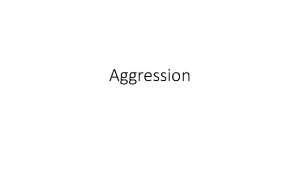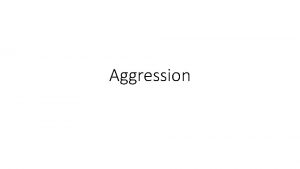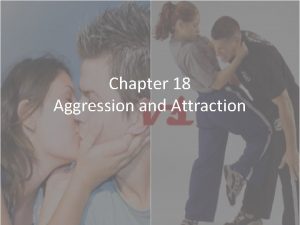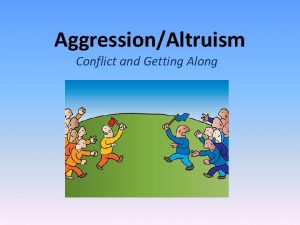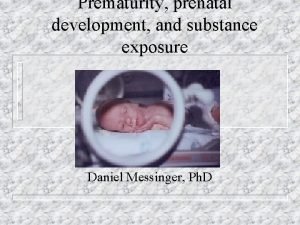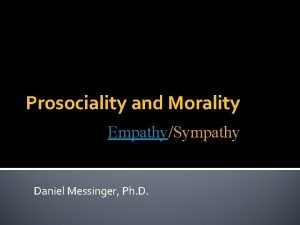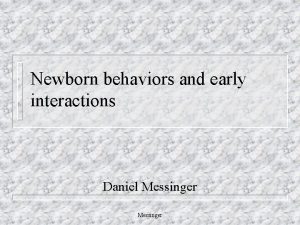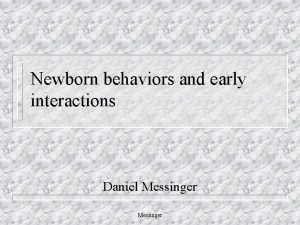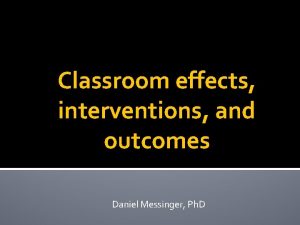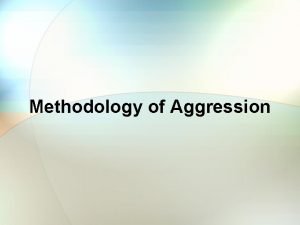Aggression and RiskTaking Daniel Messinger Ph D Overview















































- Slides: 47

Aggression and Risk-Taking Daniel Messinger, Ph. D

Overview �Temperament and social inhibition �Gene*environment interaction & self-regulation �More on aggression �Risk-taking Presence of peers Presence of adult


Trajectories of Social Reticence 3 Class Model of Social Reticence Trajectories • High-Stable (n=43, 16% of sample): High level of social reticence at 2 years, with consistently higher levels and small increase over time • High-Decreasing (n=112, 43% of sample): High level of SR at 2 years, with significant decrease over time • Low-Increasing (n=107, 41% of sample): Lower level of SR at 2 years, with significant increase but still consistently low SR over time

SR Trajectory Predicts Symptoms of Psychopathology Trajectories significantly different for internalizing and externalizing problems: • High-Stable SR trajectory predicted greatest internalizing problems • Low-Increasing SR trajectory predicted greatest externalizing problems • High-Decreasing SR trajectory predicted least problems


Self-Regulation Background �“Volitional act of managing attention and arousal in a manner that facilitates goal-directed behavior” �Rapidly developing in childhood Involves managing, modulating, inhibiting, and enhancing attention behavior and emotions �Related to social and academic success �Needed for successful transition into kindergarten High quality child care may facilitate children’s SR skills

Self-Regulation �Mixed evidence linking increased exposure of child care to development of behavior problems -> low levels of self-regulation �Genetic and experiential differences may cause children to differentially respond to their experiences (differential susceptibility) �DRD 4 7+ allele may moderate the effects of children’s experiences on developmental outcomes thought to reflect SR skills

Study Aims Test the degree to which children’s early childcare experiences (quality, quantity, & type) predict SR skills in prekindergarten 2. Test the degree to which these relations are conditional on genotype (DRD 4 7+) 1.

Measures � Self-Regulation: Continuous Performance Task – computer based task where children press a key if the stimulus is presented on the screen ▪ More errors is associated with lower academic achievement and higher levels of aggression & inattention ▪ Higher errors = higher inattention Day-Night Stroop – card task where children say “day” if they see a picture of the moon and “night” if presented with a picture of the sun ▪ Higher scores indicate more inhibitory control Delay of Gratification – children asked to wait 7 minutes to receive a larger prize ▪ Waiting 7 min reflects more “desire based” inhibitory control Latent measure of inattention – made up of teacher report forms and observational measures

Measures cont. �Quantity of childcare - averaged hours in non- maternal care per week Collected every 3/4 months until 54 months �Quality of childcare – caregiver-child interactions at 6, 15, 24, 36, and 54 months Rated on various likert scales at different intervals �Type of childcare – center-based care children spent more than 50% of time in non-maternal care

Measures cont. �Genotype – DNA collected at 15 years old DRD 4 7+ was coded if homozygous or heterozygous for the 7 -repeat allele versus those without a copy of the allele

Childcare, Inhibitory Control & Inattention: DNS � DRD 4 7+ children who spent fewer hours in nonmaternal care showed more effective performance on the DNS task than DRD 4 7+ children who spent more hours in childcare � The beneficial effect was present for DRD 4 7+ children in few hours of childcare but was not a risk factor for children with high number of hours in childcare

Childcare, Inhibitory Control & Inattention: DOG � DRD 4 7+ children in few hours of childcare had better inhibitory control in DOG task � Difference was only present for children attending few hours of childcare

Continuous Performance Task Results � Inhibitory control – higher quality care was associated with fewer commission errors on the CPT � Attention – DRD 4 7+ allele is associated with more effective attention when children spend fewer hours in childcare

Inattention & Impulsivity Results � DRD 4 7+ allele is associated with lower levels of inattention/impulsivity if children experience few hours of childcare � Descriptively, DRD 4 7+ allele is associated with higher levels of inattention/impulsivity if children experience high number of hours in childcare

Questions? � Thoughts on finding a weak link between the quality of children’s child care experiences and the development of their SR skills? � What are practical implications of their finding that DRD 4 7+ children with less exposure to child care showed more effective SR skills?

Human aggression �Types �Reactive and proactive aggression �Overt and covert anti-social behavior

Granic & Patterson, 2006


Age-related decreases

Model

Coercion noncompliance �A parallel process growth model … revealed the amplifying effect of observed coercive caregiver–child interactions on children's noncompliance � But child oppositional and aggressive behaviors did not consistently predict increased coercion. The slope and intercept of child oppositional and aggressive behaviors and the stability of caregiver–child coercion were predictive of teacher-reported oppositional behavior at school age. Families assigned to the Family Check-Up condition had significantly steeper declines in child oppositional and aggressive behavior and moderate reductions in oppositional behavior in school and in coercion at age 3. Results were not moderated by child gender, race/ethnicity, or assignment to the intervention condition.

Relational aggression � “Attempts to harm the victim through the manipulation of relationships, threat of damage to them, or both” (Crick et al, ’ 02 p. 98) � Associated with internalizing/externalizing problems and later peer rejection Preschool • Direct, face-to face behaviors • Exclusion from party Middle Childhood • More sophisticated, direct and indirect behaviors • Direct: refuse to choose as a team member • Indirect: spread a rumor Adolescence • Sophisticated and focused on opposite-sex relationships • Stealing a boyfriend


Background �Aggression- behavior intended to hurt, harm, or injure another person �Forms: Physical Relational �Functions: Proactive Reactive �Most measures confound function and form

Forms and Functions of Aggressive Behavior (Murray-Close & Ostrov, 2009)

Predictors


Background � Teenagers engage in more risky behaviors than adults More likely to binge drink, smoke cigarettes, have casual sex, be involved in a fatal or serious car crash � Adolescents take a substantially greater number of risks when driving when observed by peers � Risk-taking related to brain systems: Incentive processing system Cognitive control system

Background �Incentive processing system ▪ The ventral striatum, orbitofrontal cortex, and others ▪ Decision making = valuation and predication of rewards/punishments ▪ Under re-organization during adolescence = heightened sensitivity to reward �Cognitive control system ▪ The lateral prefrontal cortex ▪ Decision making = goal-directed, keeping impulses in check ▪ Gradual and protracted development until early 20’s �Adolescence = heightened sensitivity to reward and under-developed impulse control

The Stoplight driving game � As the vehicle approaches intersection, light turns yellow Chance crash or break and wait � Risk-taking = not breaking for yellow light

Methods � Manipulation of social context (peer vs. alone conditions) All participants brought two same-age, same-sex, friends Change of social context = “Surprise manipulation” � Self-report questionnaires: • Complete after f. MRI session • Barratt Impulsiveness Scale • Zuckerman Sensation Seeking Scale • Resistance to Peer Influence (RPI) Scale

Behavioral results While in the ‘Alone’ condition, self-reported… - Sensation seeking predicted greater risky driving behavior - Impulsivity did not predict risky driving behavior

f. MRI Results

Self-reported resistance to peer influence correlated with neural peer effect

Only adolescents took more risks when being observed by peers � Adolescents, but not adults, had greater VS and OFC (reward system) activation in the peer condition vs. alone Adults don’t perceive task as rewarding? Adults don’t perceive presence of peers as rewarding? ▪ Better able to recruit the LPFC to suppress reward system outputs ▪ ^ LPFC = greater reliance on deliberative strategies with decision making � Adults, but not adolescents, engaged multiple LPFC sites more robustly than adolescents Not dependent on social context (i. e. , presence of peers)

Borenstein

Background �Presence of peers increases risk tasking among youth Real or illusory Effects not observed in adults �Prior research focused on link between parental monitoring and teen misbehavior Do non-familial adults affect risky decision making within groups? Borenstein

Background �Impact of peers on adolescents’ risk taking is often unconscious Peers heighten adolescents’ sensitivity to potential rewards Especially true for immediately available rewards Temporal discounting of rewards steeper when observed by peers �Could these mechanisms account for the moderating effect of adult’s presence on risky decision making? Borenstein

Hypotheses � The presence of a somewhat older adult mitigates the peer effect on adolescents’ risk taking This mitigation is explained by attenuation of the impact of peers on adolescents’ preference for immediate rewards Borenstein

Methods � Funded by the U. S. Army How best to group soldiers in combat teams � Males in late adolescence recruited from colleges in Philadelphia, PA Other subjects recruited via Temple University’s intro psychology classes 18 -22 years of age � 3 social-context situations Solo- tested alone Peer-group- observed by 3 same-age peers Adult-present- 2 same-age peers and 25 -30 year old confederate Borenstein

Methods (Cont. ) � Peer and adult present conditions constructed to resemble fire teams employed by the military Testing completed in 2 phases 1. Recruitment and testing of solo and peer group conditions 2. Recruitment and testing of adult-present condition � Recruitment stopped when N=100 per condition Effect sizes of d=. 47 and d=. 4 found in similar prior studies � � 10 subjects excluded from final analysis due to incomplete data Borenstein

Procedure � Encouraged participants to recommend friends to act as peers � Phase 1: Group of 5 - four subjects randomly assigned to peer group and one to alone condition One member from peer group randomly assigned as subject and performed test while others observed Left in room for 10 minutes to interact naturally � Phase 2: three instead of four subjects (adult-present condition) 12 confederates took turns acting as the fourth subject Left in room for 10 minutes to interact naturally AND share their names/year in school (confederate introduced as grad student) � 56 -59% of group conditions included friends Borenstein

Measures � Risk Taking – Stop light computerized driving task Goal to reach end of track as quickly as possible 32 intersections with yellow lights ▪ Decide whether to stop vehicle via spacebar and lose time, or go through the intersection with possibility of crash Proportion of intersections crossed w/out stopping = risk Subjects and observers told about $15 bonus for performance � Preference for Immediate Rewards – Delay discounting task Small immediate reward vs. large delayed reward Delayed reward constant at $1, 000 ▪ Delay interval (1 wk, 1 mo, 6 mo, 1 yr, 5 yrs, 15 yrs) (randomized) Immediate reward = $200, $500, or $800 (randomized) Nine choices presented in succession – previously chosen rewards cut in half for next choice (e. g. , delayed choice= $1, 000 -> next delayed option = $500) Ending value reflects discounted value of the delayed reward (average indifference point) Borenstein

Does the presence of an adult influence risk-taking behavior? � Peer group subjects took significantly more risks in the game, when compared to solo (p<. 001) and adult present conditions (p<. 002) � Subjects in the adult present condition did not differ from the solo condition (p=. 83) Borenstein

Does adult reduce peers’ influence on preference for immediate rewards? � Subjects in peer group exhibited a lower indifference point Significantly different than solo Marginally different than adult-present � Discount rates paralleled indifference points Higher discount rate= greater orientation towards an immediate reward Peer group exhibited significantly greater discount rate, compared to solo and adult -present � No differences between solo and adultpresent groups for indifference points and discount rates Borenstein
 Daniel messinger
Daniel messinger Daniel messinger
Daniel messinger Daniel messinger
Daniel messinger Daniel messinger
Daniel messinger See aggression do aggression
See aggression do aggression See aggression do aggression
See aggression do aggression David messinger rit
David messinger rit Bruce messinger
Bruce messinger Chapter 27 anger aggression and violence
Chapter 27 anger aggression and violence Stages of assault cycle
Stages of assault cycle Self fulfilling prophecy examples
Self fulfilling prophecy examples Outline the role of genetic factors in aggression
Outline the role of genetic factors in aggression Examples of verbal aggression
Examples of verbal aggression Conformity definition ap psych
Conformity definition ap psych Two factor theory psychology
Two factor theory psychology Mauritania white moors
Mauritania white moors Types of aggression in psychology
Types of aggression in psychology Aggression risk assessment
Aggression risk assessment Agression theories
Agression theories Undoing defense mechanism examples
Undoing defense mechanism examples Instrumental aggression
Instrumental aggression Frustration-aggression principle
Frustration-aggression principle Aggression defence mechanism
Aggression defence mechanism Anger replacement training
Anger replacement training Example of direct aggression
Example of direct aggression Assertive behaviour in sport examples
Assertive behaviour in sport examples Definition aggressive
Definition aggressive Hostile aggression
Hostile aggression Social determinants of aggression
Social determinants of aggression International response to german aggression
International response to german aggression Productive reactions to fear include freezing
Productive reactions to fear include freezing Aggression in the pacific map
Aggression in the pacific map Anger vs aggression
Anger vs aggression Social learning theory of aggression
Social learning theory of aggression Lapiere 1934 study
Lapiere 1934 study Big bob agression
Big bob agression Biological explanations of aggression
Biological explanations of aggression Karrie miller
Karrie miller Effects of aggression
Effects of aggression Hcr-20
Hcr-20 3 reasons you should use the supportive stance
3 reasons you should use the supportive stance Behavior chain
Behavior chain Modified overt aggression scale score interpretation
Modified overt aggression scale score interpretation Aggression nature vs nurture
Aggression nature vs nurture Fear factory aggression continuum
Fear factory aggression continuum Aggression replacement training facilitator training
Aggression replacement training facilitator training Germany map 1938
Germany map 1938 Institutional aggression
Institutional aggression
